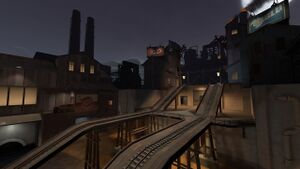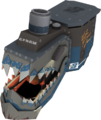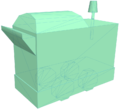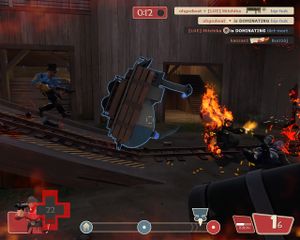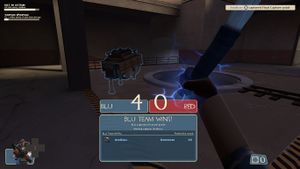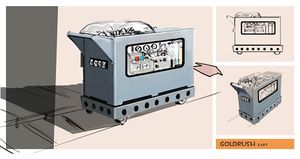Ładunek
| Ta strona jest w trakcie tłumaczenia na język polski. Jeśli mówisz po polsku, napisz na stronie dyskusji lub porozmawiaj z użytkownikami, którzy wnieśli wkład do strony (sprawdź jej historię). |
| „ | Dalej, wielki wózku-bombo!
Kliknij, by odtworzyć
— The Heavy
|
” |
Na mapach typu Ładunek, zespół BLU musi zaprowadzić wózek pełen materiałów wybuchowych przez serię punktów kontrolnych i do bazy zespołu RED w określonym czasie. Członkowie zespołu BLU przesuwają bądź "popychają" wózek, stojąc niedaleko niego - im więcej z nich znajduję się przy nim, tym szybciej się porusza. Każdy członek zespołu RED stojąc koło wózka, zatrzyma jego ruch. Jeżeli żaden z graczy z BLU nie popchnie wózka w czasie 30 sekund od jego zatrzymania, zacznie się on powoli poruszać do tyłu aż do ostatniego punktu kontrolnego/bazy BLU albo do czasu, gdy gracz BLU znowu do niego podejdzie. Wózek zachowuje się jak Zasobnik poziomu 1 dla zespołu BLU (i przebranych wrogich Szpiegów), przywracając punkty życia i amunicję graczom popychającym go.
Mapy trybu Ładunek mogą, ale nie muszą być podzielone na wiele rund. Część map posiada jednokierunkowe przejścia dla zespołu BLU, czasem zamknięte do czasu przejęcia jednego z punktów.
Mapy takie, jak Gold Rush, Hoodoo i Thunder Mountain są podzielone na trzy etapy, które zespół BLU musi przejść, aby wygrać. Pierwsze dwie części mają dwa punkty kontrolne, a ostatnia - trzy (dwie w Hoodoo), wliczając w to ostatni punkt. Mapy Badwater Basin i Upward mają jeden etap z czterema punktami łącznie z ostatnim. Przejście do następnego punktu daje więcej czasu zespołowi BLU. Dojście do ostatniego punktu powoduje przejście do następnego etapu. Gdy wózek dojdzie do ostatniego punktu na ostatnim etapie, ładunek wybuchnie, zabijając wszystkich będących za blisko i niszcząc bazę RED, symbolizując wygraną BLU.
Spis treści
Payload Race
W odróżnieniu od standardowych map trybu Ładunek, mapy typu Wyścig Ładunków zawierają dwa wózki, zarówno dla RED jak i BLU, zespoły więc nie są dzielone na atakujących i broniących. Aby wygrać, każdy zespół musi jednocześnie pchnąć swój wózek przez terytorium wroga, aby dojść do ostatniego punktu, w tym samym czasie uniemożliwić wrogowi zrobienie tego samego. Tak jak w mapach Ładunek, gracze pchają wózek stojąc przy nim, wrogowie przy nim zablokowują jego ruch, a wózek jest Zasobnikiem poziomu 1.
W odróżnieniu od Ładunku, wózek nigdy nie cofa się i nie ma limitu czasu; mapa zakończy się tylko w momencie przepchnięcia wózka do ostatniego punktu. Tor wózka może biec pod górę, co spowoduje, że niepopychany, szybko spadnie na podnóże góry. Takie części toru będą wyróżnione na pasku postępu, aby pokazać, jak daleko trzeba popchnąć wózek, aby zapobiec jego cofaniu się.
Mapy tego typu są jedno- bądź wieloetapowe. Pipeline i Nightfall są podzielone na trzy części, a Hightower składa się tylko z jednej. Wygranie jednej z pierwszych dwóch rund da przewagę wygranej drużynie w następnym etapie (wózek znajduje się trochę dalej od punktu początkowego)
Strategia
Mapy
Ładunek
Mapy trybu Ładunek zaczynają się prefiksem pl_; mapy społeczności są wyróżnione kursywą.
| Nazwa | Zdjęcie | Nazwa pliku |
|---|---|---|
| Badwater Basin | 160px | pl_badwater
|
| Frontier | 
|
pl_frontier_final
|
| Gold Rush | 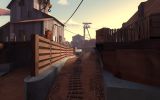
|
pl_goldrush
|
| Hoodoo | 160px | pl_hoodoo_final
|
| Thunder Mountain | 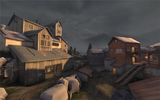
|
pl_thundermountain
|
| Upward | 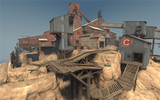
|
pl_upward
|
| Barnblitz | 
|
pl_barnblitz
|
Wyścig ładunków
Mapy trybu Wyścig ładunków zaczynają się prefiksem plr_; mapy społeczności są wyróżnione kursywą.
| Nazwa | Zdjęcie | Nazwa pliku |
|---|---|---|
| Hightower | 
|
plr_hightower
|
| Nightfall | 
|
plr_nightfall_final
|
| Pipeline | 
|
plr_pipeline
|
Wózki
Wózki to cel i centrum trybów Ładunek i Wyścig Ładunków.
Wózki poruszają się na torze kolejowym; celem jest przepchnięcie ich wzdłuż tych torów, w czasie, gdy wrogowie próbują temu zapobiec. Wózek jest popychany przez stanie koło niego - im więcej graczy stoi w jego okolicy, tym szybciej się porusza (aż do maksymalnej liczby trzech - patrz sekcja Szybkości niżej). Jeżeli jakikolwiek przeciwnik dojdzie w okolice wózka, jest on blokowany, a wózek nie ruszy się, dopóki wrogowie nie zostaną usunięci. Jeśli jakikolwiek budynek Inżyniera znajdzie się na drodze wózka, jest on niszczony, gdy wózek wjeżdża na niego. Wózek działa jak Zasobnik poziomu 1 dla zespołu, który go popycha, przywracając punkty zdrowia i dostarczając amunicję i metal. W odróżnieniu od zasobników poziomu 1, wózek nie posiada limitu ilości metalu dawanego Inżynierom. Wózek dostarcza także amunicję i zdrowie przebranym Szpiegom.
If a cart is left unattended on specific slopes that ramp on an incline, it will naturally roll down backwards. The cart-pushing team must push it continuously to get it up such hills, whereas reaching an inclined slope becomes a sort of checkpoint that the cart cannot reverse past. As of the Engineer Update, the cart has a glowing, team-colored outline effect that enables its position to be identified through walls and from further away, allowing players to keep an eye on its whereabouts at all times.
Payload
In Payload mode, the BLU team must push a cart through a series of checkpoints and into the RED team's base within a certain amount of time. Reaching a checkpoint adds time to the timer. If a BLU player does not push the cart after 30 seconds have passed, the cart will start slowly moving backwards until it reaches a checkpoint/BLU spawn or a BLU player stands next to it again. If the cart is not moving backwards when time runs out Overtime will occur, which gives the attacking team five seconds to move the bomb or they lose. The timer resets each time the cart is touched.
Payload Race
In Payload Race mode, both teams are issued a cart. The teams must simultaneously push their cart through enemy territory while preventing the enemy team from doing the same. Unlike Payload maps, the cart will not move backwards after any length of time (unless it is on an inclined slope) and there is no time limit; the map only ends when one team successfully pushes their cart to the finish point. Payload Race maps tend to use rolling slopes much more than standard Payload maps. During Overtime, both carts will automatically move forward slowly to prevent Stalemates. Pushing one cart stops the other from moving forward by itself.
Lil' Chew Chew
On the Payload map Frontier, a substantially larger mechanized train engine known as Lil' Chew-Chew is used in place of the standard BLU cart. Providing cover from frontal attacks, the Train is capable of significantly damaging anyone who finds themselves (whether willingly or forcibly) in its mouth when it is moving forwards; the damage done increases as more players ride its rear platform to the point where three or more attackers cause it to deal an instant-kill. The platform also has a built-in BLU Dispenser, however, those riding on it will have trouble seeing directly in front of the cart as the main body of the train is in the way. It has a noticeably increased pushing range when compared to normal carts.
Cart speeds
The cart speed depends on the amount of people (the multiplier) that are pushing. Currently, all Standard Payload maps use the same speeds. Speeds are measured in Hammer units per second. Note that the capture limit is 3 players, and any additional players who push it will not increase the speed further.
| Multiplier | Speed | Rate |
|---|---|---|
| (Backwards) | -9 | -10% |
| x1 | 50 | 55% |
| x2 | 70 | 77% |
| x3 | 90 | 100% |
Gallery
Carts
The BLU team's bomb cart.
The RED team's bomb cart, seen only on Payload Race maps.
The special model for the cart on Hoodoo.
The special cart, Lil' Chew Chew, found on Frontier.
Concept art
Unused models
The following models are present in the game files, however, remain unused.
Related achievements
 Skaut
Skaut
|
 Żołnierz
Żołnierz
|
|
 Demoman
Demoman
|
|
 Gruby
Gruby
|
|
 Inżynier
Inżynier
|
 Szpieg
Szpieg
|
Update history
Aktualizacja z 29 kwietnia 2008 (Gold Rush Update)
- Added the Payload gametype
- Added Gold Rush map
Aktualizacja z 19 sierpnia 2008 (A Heavy Update)
- Added Badwater Basin
- Added proper handling of cart blocking recognition to Payload maps
- Added new community contributed Payload Cart response rules for Sniper.
Aktualizacja z 13 października 2011 (Manniversary Update & Sale)
- Responses related to cart progress no longer play when disguised.
Aktualizacja z 17 kwietnia 2012
- [Nieudokumentowane] Payload carts no longer maintain player overheal.
- Added Enabled/Disabled inputs for the mapobj_cart_dispenser entity
Aktualizacja z 27 czerwca 2012
- Fixed cases where the Payload HUD looked like the cart is still on a hill when it isn't
Bugs
- The cart may sometimes randomly spin vertically.
- The capture progress HUD sometimes does not report how many players are pushing the cart. It may also display the cart as being blocked when it is not.
- Dying due to the cart explosion causes the Deathcam to focus on a specific point of the map while displaying the name of an opponent, even if no enemy was involved in the player's death.
- It is possible to derail the cart as it is falling by launching it with an explosion. This works because it becomes a physics prop when it reaches the end of the track.
Trivia
- The default Payload takes the shape of a "Fat Man" implosion-style plutonium atomic bomb. This type of bomb was dropped over Nagasaki during World War II.
- Originally, an Engineer could upgrade the Dispenser on the cart, allowing it to give increased healing, ammo, and metal. This has since been fixed.
- Hoodoo uses a different cart model. The map description reveals the cart to be carrying a "dirty bomb" – a nuclear explosive consisting of little more than radioactive material strapped to conventional explosives, such as TNT.
- On all of the carts, there is a Heavy quote written into the paintwork:
- The default cart bears the words 'Cry some more' scratched into the paintwork.
- The Hoodoo cart has the words 'So much blood!' painted in white on the front-most barrel and the word 'Bonk' written in dust underneath one of the straps (most likely by the Scout).
- Lil' Chew-Chew bears the words 'All of you are dead!' scratched into the paintwork in front of the smoke stack.
- The light on the Payload cart is the same as the one duct-taped on the Combat Mini-Sentry Gun.
| ||||||||||||||||||||

